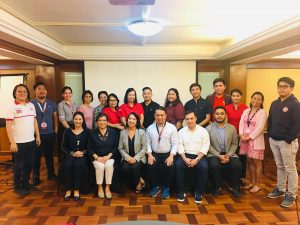Addressing Child Protection in Philippine Disaster Laws
By: Seth Sarmiento (IFRC) and Aries Burgonio (Philippine Red Cross)
August 2019
Children are the most vulnerable and most affected sector of society in any disaster event. The Philippine Statistical Authority reported in 2018 that there are more than 30 million children in the Philippines that may be at risk to disasters. In the same year the World Risk Report also ranked the Philippines third among countries with very high disaster risk.
 To address this issue, IFRC launched a global research that focuses on three main issues: systems to protect unaccompanied, separated and orphaned children, children’s access to education, and the participation of children in disaster risk management. The Philippines was chosen as one of five countries to conduct a case study because of its past experience in largescale disasters and its advanced legal framework on child protection issues. The case study aims to review national legal and policy frameworks on child protection and disasters.
To address this issue, IFRC launched a global research that focuses on three main issues: systems to protect unaccompanied, separated and orphaned children, children’s access to education, and the participation of children in disaster risk management. The Philippines was chosen as one of five countries to conduct a case study because of its past experience in largescale disasters and its advanced legal framework on child protection issues. The case study aims to review national legal and policy frameworks on child protection and disasters.
The Philippine Red Cross (PRC), supported by IFRC and Canadian Red Cross, carried out the case study in the Province of Leyte that was severely affected by Super Typhoon Haiyan in 2013. Key informant interviews and focus group discussions with children and parents were conducted to gather data on their experiences after Super Typhoon Haiyan devastated their communities. Key government officials were also interviewed to have a deeper understanding on the existing laws and policies on safeguarding children’s rights pre in pre- and post-disaster events.
Following the data collection, initial findings and results of the case study were presented for an expert peer review and roundtable discussion last July. PRC staff from the Disaster Management Services and the Welfare Services together with representatives from the Department of Social Welfare and Development (DSWD), the Department of Education (DepEd), United Nations Children’s Fund (UNICEF), the University of the Philippines College of Social Work and Community Development (UP-CSWCD) and Save the Children Philippines were gathered for the discussion.
Aside from looking into the laws and policies for child protection in emergencies and disasters, the case study also looked into the different programs and services of government and non-government organizations for children and families affected by disasters. One of this is the Rapid Family Tracing and Reunification (RFTR) where personal information and photographs of children are collected to support the search for and reunification of their family members. This service was initially used by the DSWD and UNICEF in the aftermath of Typhoon Haiyan. Similarly, even before RA 10821 was passed, the Philippine Red Cross had already implemented its Restoring Family Link (RFL) services during the Typhoon Haiyan Emergency Operations, and this is highlighted as a good example of how National Societies can effectively support services for child protection in disaster contexts.
Though outside of the scope of the case study, sexual and gender based (SGBV) violence cases against children and women which occurred after Typhoon Haiyan were also discussed during the roundtable discussion. The Philippine Red Cross is now doing a pilot of the SGBV project in two Typhoon Haiyan affected areas namely Aklan and Tacloban. The discussions had led to the recommendation for PRC to conduct further research on this area.
The Philippines case study has now been finalized and it concluded that actual implementation of the primary law on child protection in disasters — the Children’s Emergency Relief and Protection Act (RA 10821)– first requires concrete funding mechanisms for its mandatory activities at the barangay level which is closest to the community. The funding gap is linked to low awareness and socialization of the important provisions of the law. This means that while there are existing funds which may be utilized for some of these activities, such as the local DRRM fund, child protection activities under this law have not been programmed in the local budget and have therefore not been implemented for the most part.
Another recommendation is for PRC to strengthen its child protection program by aligning with and mainstreaming the activities under RA 10821. At the Chapter level, information dissemination and capacity building on RA 10821 should also be carried out.
![]()

